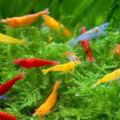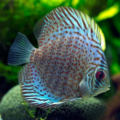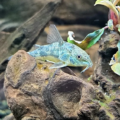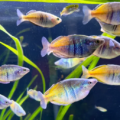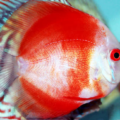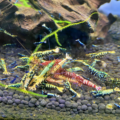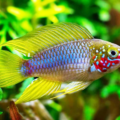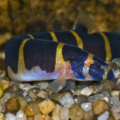Explore the warm, colorful world of Red Melon Discus and how to look after them the right way in this guide!

Our aquarium guide for Red Melon Discus is where helpful care meets expert tips to keep your fish active and healthy in its home.
The Red Melon Discus needs little introduction. Its striking red color and calm demeanor in a tank are bound to capture your heart. It is also a great centerpiece fish for a heavily planted home tank.
This freshwater fish has a large following among aquarists and hobbyists for adding radiance, personality, and life to aquariums worldwide.
This guide is the ultimate Red Melon Discus overview, curated to update your knowledge on tank setup, healthy discus diet, breeding process, and compatible tank mates to double the fun and vibrant discus care.
Understanding the Appearance of Red Melon Discus

Can’t get enough of the Red Melon Discus’ physical makeup; here’s more information to feed your curiosity.
Color Pattern: The Red Melon Discus is the classic representation of an elegant appearance featuring unique discus color traits, including a rich orangely-red body and a reddish-orange or pale yellow face.
Size: A vibrant red discus fish averages about 6-8 inches in adult size.
Unique Traits: The fish also has a smooth, round body with no vertical barring, a common feature on discus fish that gives it a sleek look.
For Red Melon Discus’s appearance, its coloration can be enhanced with proper care and a diet rich in beta carotene. This gives it a standout status in any tank and showcases a gorgeous blend of beauty that makes it highly admired in the hobbyist world.
Setting Up the Ideal Tank for Red Melon Discus
The ideal Red Melon Discus tank setup demands close attention to essential details, including tank size, water conditions, and environment, to ensure your freshwater pets survive.
A stable, clean, and spacious environment with low water flow is also a necessity on your list of tank setup essentials. Check the water parameters list below to ensure the right discus tank conditions.
| Required Tank Size | 75 gallons for a breeding pair |
| Ideal Water Temperature | 82- 860F |
| pH Level | 6.0- 6.5 |
| Water Hardness | 1-4 dKH |
| Ammonia, Nitrite, Nitrate | 0 ppm, 0 ppm, 20 ppm |
More options for the best aquarium setup for red discus include substrate and decorations. Dark substrate types, like sand or smooth gravel, work best with this fish, serving as a great contrast option and increasing the aesthetic appeal of your aquarium.
It is equally important to replicate the discus natural habitat. So, introduce live plants like Moss, Java Fern, Anubias, and gentle rock formations to serve as hiding spots and enrich your tank environment without overwhelming your fish.
Feeding Guide for Healthy Red Melon Discus

Red Melon Discus fish nutrition is as fascinating as its vibrant color! They’re omnivores that feed on various nutritional frozen and meaty foods like blood worms, tubifex worms, high-protein shrimp pellets, and flake foods.
Maintaining a high-quality diet rich in protein, fats, and carotene is pivotal for their color vibrancy and overall physical and reproductive health.
This feeding guide for discus fish is incomplete without recommendations on feeding frequency and portion control since overfeeding is a harmful habit to introduce to a discus tank. So what to do?
- Juvenile Red Melon Discus should be fed at least 3 to 5 times daily
- Adult Red Melon Discus should be fed only 2 to 3 times per day
- Like most fish species, the Red Melon Discus should only be provided an amount of food they can consume within 10 minutes, and leftover meals must be extracted manually or with a proper filtration system.
For more on feeding your aquatic pets check out The Ultimate Guide to Fish Food: Pros and Cons & Best Choices!
Breeding Red Melon Discus: Key Tips for Success

Keeping the discus species is a gratifying experience, and when it comes to breeding Red Melon Discus, a stress-free environment and stable water quality will do more harm than good to the overall success of the spawning discus fish.
| Water Quality | pH level (6.0-6.5), 1-4 dKH |
| Temperature | (82-860F) |
| Lighting Conditions | Low lighting |
Discus Fry Care Tips:
Once your fry hatches, care must begin to preserve their lives and ensure they grow healthy and strong to continue the next line of vibrant Red Melon Discus fish.
- Separate the fry and parent from the general tank after 2-3 weeks and place them in a separate grower tank.
- Maintain stable water parameters to support fry metabolism and growth
- Let fry get nutrients from parents’ mucus for the first few weeks before introducing external foods such as baby brine shrimp or microworms. Crushed flakes or powdered dry food can also be introduced to their diet as they grow.
Selecting Compatible Tank Mates for Red Melon Discus

Finding the most compatible fish for discus is one way to add life and personality to your indoor aquarium.
Red Melon Discus are best paired with peaceful fish that prefer differing similar water conditions and also exist in the same size group to promote healthy social interaction in the tank and preserve a prey-predator relationship.
Compatible Species: Tetras, Cory Catfish, Loaches, Pencilfish, Siamese Algae Eaters, Rams, and Hatchet fish are some of the best discus companions you can introduce to your home tank.
Incompatible Species: Larger and more aggressive species are not the best Red Melon Discus tank mates as they can harm, stress, or, worse, feed on them.
Preventing and Managing Health Issues
Let’s check out some Red Melon Discus Health tips in this section.
Though hardy, these beauties may face some common health issues in their habitat, including stress, parasitic infections, bacterial infections, and water quality-related diseases.
However, there’s a way out! This is where discus fish disease management comes in handy through preventive care practices such as regular water changes, maintaining stable water parameters, quarantining new fish, adding copper treatment to water in case of disease breakout, and cleaning the tank of leftover food on time.
Signs of illness: Preventing discus illnesses also involves knowing the symptoms to look for in a fish tank. Check them out below.
- Color changes
- Lethargy
- Unusual swimming
- Reduced activity in the tank
- White spots on the body
- Frail-looking fins.
Extending the Lifespan of Red Melon Discus

Long-term care for Red Melon Discus requires a stable environment and a balanced diet that contributes to the fish’s lifespan. Water quality, parameters, and tank mates are important determinants in extending the Red Melon Discus’ lifespan.
More longevity tips for discus fish are below.
- Regular water changes and testing
- Appropriate diet for sharper coloration
- Avoid overfeeding discus and overcrowding their tanks, which may cause stress and spread of disease.
- Maintaining a consistent temperature and lighting of 8-10 hours of natural light daily to mimic natural cycles and curb indiscriminate algae growth.
- Applying water conditioner to control chlorine in tap water.
Conclusion
This freshwater fish is widely loved for its peaceful nature, but maintaining a vibrant discus fish isn’t something that should be joked with, whether you’re an expert hobbyist or a curious beginner looking for a starting point.
Be advised, the Red Melon Discus fish require an intensive care routine, including stable water conditions and a balanced diet to preserve their vibrant appearance and sustain their existence.
Our Red Melon Discus care guide contains all the necessary information, including feeding frequency, tank mates pairing, and preventive health measures to ensure your fish thrives. These beginner tips for discus fish will ensure you have a lovely home tank with this vibrant red fish swimming around.

